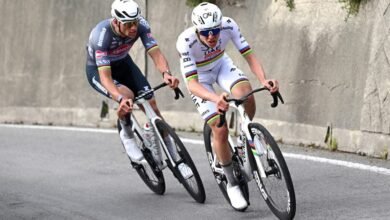How to Bike Comfortably with a Vulva

“], “filter”: { “nextExceptions”: “img, blockquote, div”, “nextContainsExceptions”: “img, blockquote, a.btn, a.o-button”} }”>
Our conversations about genital comfort on the saddle are often whispered and filled with euphemisms. However, nearly all people with a vulva will have something to say about their relationship with their saddle.
Once people do start talking candidly, there is a powerful undercurrent of stories about living with extreme discomfort, suffering injuries, and even undergoing surgeries because of how complicated it can be to bike with a vulva.
The challenges are vast and highly individualized.
To start, saddles are traditionally designed for people with male anatomy who have narrower sit bones. Many people with vulvas have wider sit bones, which need support from a saddle wide enough to relieve pressure on the soft tissue and focus weight on their bones. Also, different people find different chamois comfortable, some riders even opt for two chamois, while others wear no chamois.
Vulvas in a sweaty chamois also create a sort of petri dish where fluids, discharge, menstrual blood, and bacteria growth can contribute to discomfort and infection. Further, many people do not have symmetrical labias, or symmetrical bodies in general, meaning they may sit slightly lopsided on the saddle, often creating a chain reaction of pain through hips and knees. The more people chiming into the conversation, the more unique the challenges seem.
Fortunately, many adjustments and practices can push the tide towards comfort, from saddle to full bike fit, to pre- and post-ride practices.
Choosing cycling often means opting into the discomfort of burning legs at the top of a hill and breathing heavily. The sport can be uncomfortable, but pain from a saddle is largely avoidable.
Before thinking that you may be an exception to this idea, know that it’s not straightforward and there is no magic ticket, but there are brilliant minds, community resources, and a growing conversation to help move you towards comfort.
Saddles
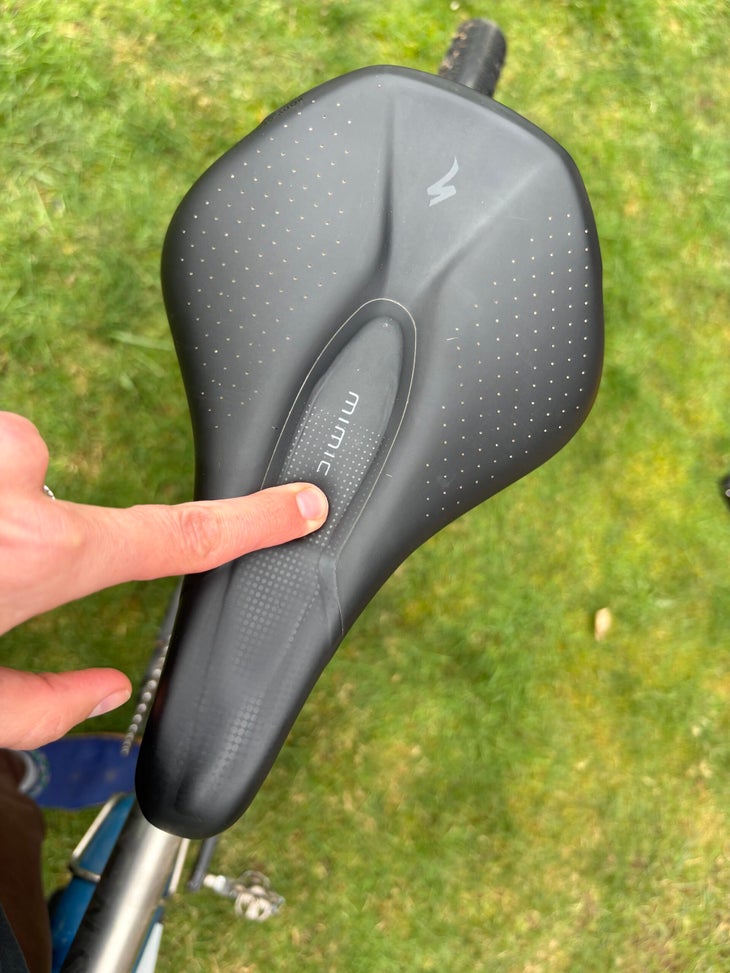
In the last decade, technology around saddles has ballooned, spurred when Specialized created the first Power saddle originally designed for Evelyn Stevens, who held the Women’s Hour Record in 2015. The saddle was wide in the back and featured a short nose and a center cutout, designed to distribute weight to the sit bones and reduce pressure for the soft vulva tissue. This saddle was revolutionary, and many companies have created similar styles since.
The Power saddle made significant impacts, but there was still space for improvement. Andy Pruitt Ed.D., a biomechanist contractor with Specialized was given a task to solve the epidemic of riders in the women’s pro peloton who were still suffering from pain on their saddles. More and more women reported opting for surgeries, such as a labiaplasty (which is still sometimes necessary, according to Pruitt), which cut back the bulk of the labia in order to reduce friction and swelling while riding.
Pruitt, inspired by the process of fitting prosthetic limbs using a clear socket, asked Specialized to make clear plastic versions of the Power saddle. He then brought 10 highly competitive women into the lab and asked them to ride naked to start understanding the pressure their labias were under while riding.
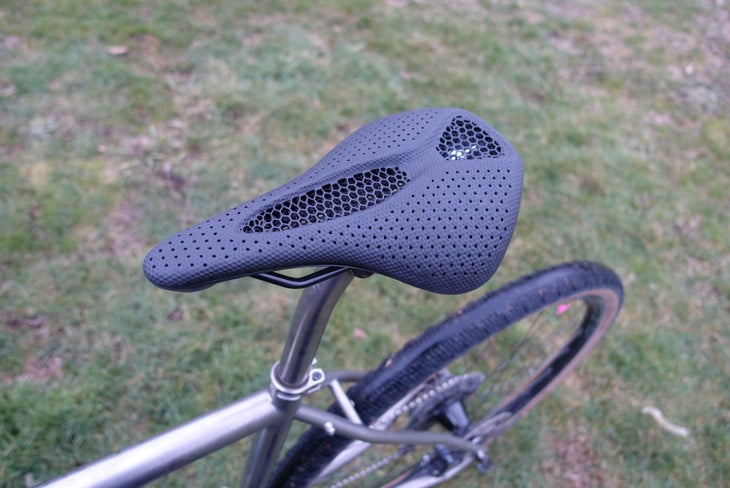
From there, Pruitt started looking for parts of the vulva experiencing two things: ischemia and edema. Ischemia is the result of tissue experiencing limited blood flow, while edema occurs when there is fluid buildup in a specific area.
Unfortunately, Pruitt says that “the longer they sat there, the more their labia began to swell and engulf itself into the cutout.” Tissue under the riders’ sit bones would go white, indicating edema in the labia. According to Pruitt, the weight of the rider’s body rested on the bones rather than the soft tissue in between.
“The reality was they were feeling pressure from the tissue swelling,” Pruitt adds, because the “Labia had acquired the cutout’s shape. When they get off the bike, the fluid migrates [to the labia], then they can never get comfortable again.”
Pruitt took this information and began iterating, eventually creating Specialized Power saddle with Mimic, a foam “lake” that filled in the cutout on the saddle and resembles the squishiness of flesh. The Mimic technology gently holds the labia as opposed to letting it squish into the cutout.
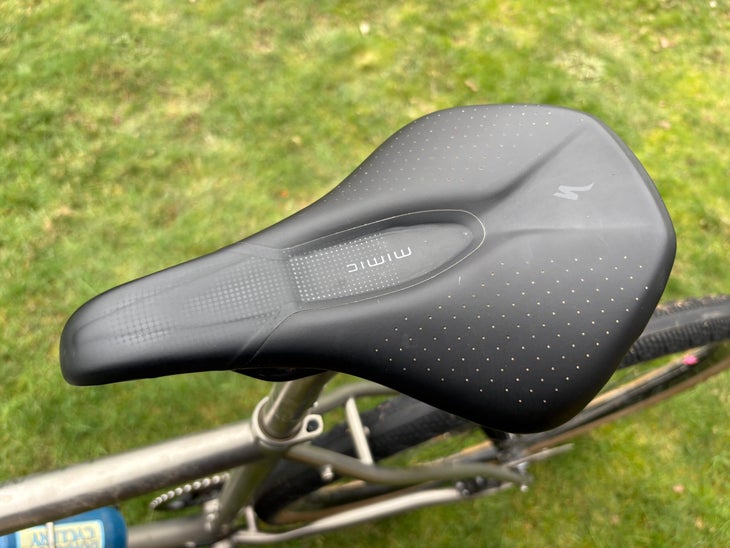
The Power saddle with Mimic is hugely popular across disciplines. Interestingly, though it was designed for vulvas, nearly 40% of the sales are now to people with male anatomy, a pleasant surprise for Pruitt.
This innovation offers suggestions for how riders can select saddles that might work for their specific body.
First, is your saddle wide enough? Many saddles offer different widths to ensure the rider’s sit bones can sit firmly on the foam instead of falling off the sides. A bike shop or an at-home test, like the one shown also create a sort of petri dish, outline the process to accurately measure sit bone width.
The cutout of the Specialized Power saddle originally provided space for the labia, and then the Mimic addition made this space supportive for the tissue. This offers insight into solutions. If your labia feels like it’s squished or pressurized in a cutout as you ride, a supporting indent like the Mimic may alleviate pressure.
When asked what some riders might like from a saddle with a different shape, Pruitt replied, “I don’t know, and I don’t really care. Whatever works for your body is great. The Mimic was made for 10 specific riders, and everyone’s anatomy is different.”
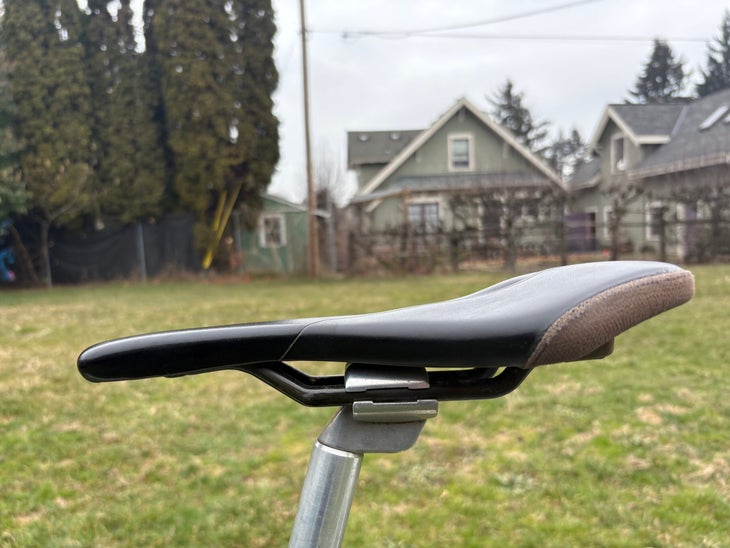
In that vein, some cyclists still prefer sticking to a cutout saddle such as the Power, the Liv Approach saddle, the Ergon SR Pro Women or the Fizik Vento Argo, feeling like the open gap fits their body more comfortably.
Alternately, some riders prefer a saddle such as the unique ISM PN 1.1 U-shaped saddle which prioritizes movement and thigh clearance or a saddle from the SQ Labs line which offers a step design to relieve pressure on the front soft tissue and also utilizes customizable lateral flex to match movement of the pelvis.
One critical step towards comfort is finding a way to test several saddles. Some shops offer a saddle library where riders can try different saddles before buying one. Many companies that make saddles offer programs to return a saddle that doesn’t work for your body after you spend some time with it on your bike.
The goal is to find the aha moment where your body feels immediately comfortable and stays that way for the duration of the ride.
Bike Fit
A proper bike fit is critical to feeling comfortable on the saddle. Likewise, the saddle is critical to a bike fit. Pruitt says, “Saddles are the center of the bike fit universe, but the right saddle in the wrong place is no better than the wrong saddle.”
One of the first questions a bike fitter should ask is about your relationship with your saddle. This includes details such as how your soft tissue feels on your saddle, if you experience chafing, or if you find yourself adjusting often to avoid pain or hot spots. Each of these answers is individual, specific, and important to achieve a proper fit.
From there, Pruitt continues to outline how a bike fit should start with saddle adjustments. Adjusting the saddle’s fore and aft, the tilt, and the height can all affect comfort. Likewise, each adjustment can affect the previous, making the process somewhat cyclical.
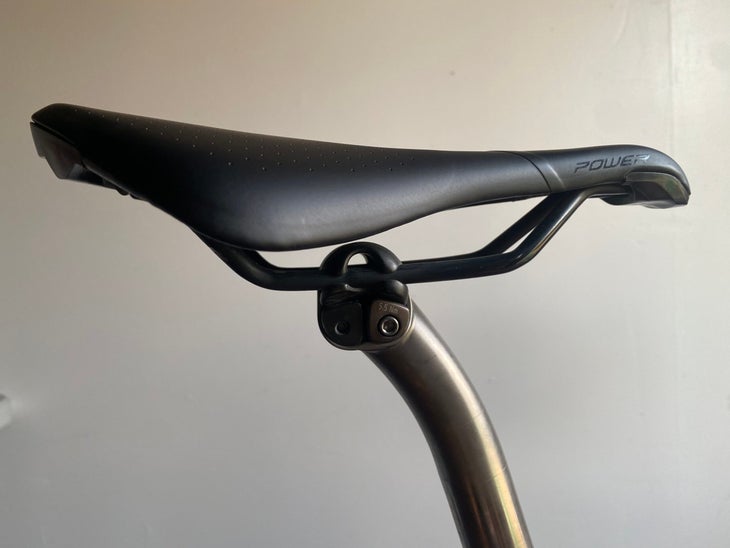
The proper saddle should allow nerve signals and blood to flow easily to soft tissue and concentrate pressure on the sit bones. Pruitt recommends first ensuring the saddle is wide enough and is not centering weight on soft tissue.
“Start with a level saddle, and if the saddle has shaping or contours, start by leveling the front third of the saddle,” says Pruitt. “Then use find saddle height using functional knee bend and ankle position to find a beginning height. After, address saddle tilt.”
Pruitt went on to say that there can be problems if the saddle’s nose is angled wrong. Angled up too far, and it creates pressure on the clitoris or the pubic symphysis, the bone that connects the front of the left and right pelvic bones. Additionally, this type of pressure can come from lordosis. Also known as swayback, this pressure comes from riders tilting their pelvises too far forward, creating pressure on nerves and arteries.
“This is a little bit like chasing your tail,” Pruitt continues. “You may need to repeat the process as you move through the full fit.”
What do you do if you experience numbness and lack of sensation while riding a bike?
Some riders experience numbness or lack of sensation related to their saddle. Pruitt outlines how it can be from “either cutting off nerve flow or vascular flow.” Like most any other discomfort from riding a bike, this too can be solved.
Chamois
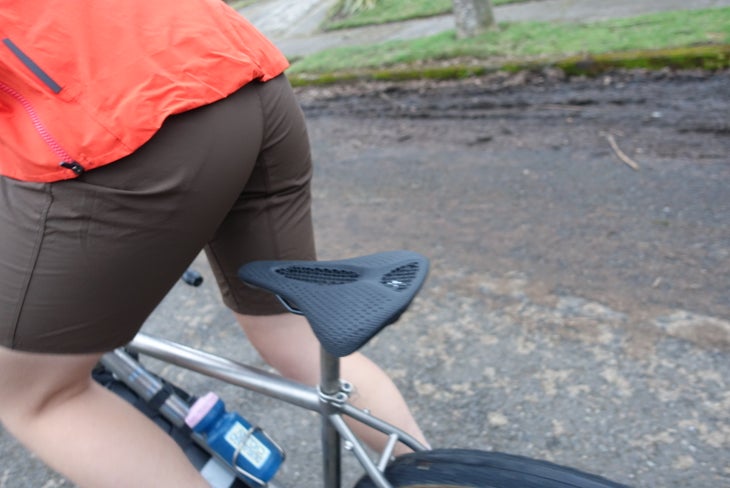
Starting with basics, a chamois is the padding in a pair of cycling shorts. Cycling shorts are designed to be worn without underwear. While a chamois can add some comfort while riding on a saddle, it is not a replacement for the correct saddle or bike fit.
Similar to a saddle, correct chamois often comes down to preference. Some cyclists always wear a chamois while others, even ultra-distance bikepackers, opt to ride chamois-free for hundreds of miles.
Just like a saddle, working to find the right size chamois and cycling shorts is important. A cycling short should be snug, which limits the amount of moving fabric that can create chaffing or hot spots.
Longtime racer Rebecca Gross highlights how a proper fit might prevent problems: “My biggest thing was realizing the bottom elastic on your bib legs must be tight or they crawl up and the chamois bunches up on the edges and rubs me raw!”
Chamois cream

Chamois cream is a product cyclists may use to reduce chafing and provide some antibacterial barriers between the skin and the chamois. The cream is typically applied to the vulva externally or other areas that may rub on the saddle. Some riders use a large glob of chamois cream, while others feel great with a pea-sized dollop.
Chamois Butt’r makes a version designed specifically to support the sensitive pH of the vagina while also containing some antibacterial properties.
Cleanliness
Chamois may be great for comfort, but they can also be optimal environments for bacteria growth. Washing a chamois properly will not only keep it in good shape for longer, but will prevent buildup of stinky or harmful bacteria.
Ideally, minimizing the time spent in a chamois can be helpful practice in reducing bacteria overgrowth. If yeast infections, UTIs, or infected ingrown hairs could be contributing to discomfort, aim to get out of your chamois as soon as possible.
Changing into an organic material such as cotton or wool underwear paired with breezy pants could make an impact. Some riders who want to avoid added chamois time will even carry extra shorts if they stop to get lunch after a ride or need to drive home.
Unlike one-day rides, bikepacking offers added challenges. Many bikepackers deem carrying enough clean chamois for each day of bikepacking unreasonable due to the space needed to carry additional clothing.
Bikepacker Robyn Thomas outlines how on nearly every trip she expected to get a mild yeast infection. Thomas resigned to consistently carrying boric acid suppositories and Azo in her med kit. Thomas finally found relief in organic materials. She now almost exclusively uses the Mon’s Royale Epic Merino Bike Liner shorts, finding that the natural wicking and antimicrobial properties of Merino wool prevented yeast infections.
Bacteria and other germs can come from a sweaty chamois but can also proliferate on the body regardless of chamois. According to Healthline and the Mayo Clinic, vulvas are considered self-cleaning and only need to be washed with water; no soap is necessary. Discharge is the vagina cleaning out anything unwanted so the “good” bacteria can proliferate and maintain the correct pH levels. Using soap can strip away the bacteria we want, leaving room for harmful bacteria to grow.
Menstruation offers yet another challenge. Cyclist Beija Flor outlines her routine while riding and bikepacking while menstruating. Flor has found silicone menstrual cups are the “only way to go” for her. Even though water typically does enough to stay clean, Flor opts to also use body wash made by Fur. Fur says its body wash is pH-balanced and gynecologically tested. This is particularly important while bikepacking when a shower is not available. Further, it’s easy to use: apply it to skin and then rinse it off with water from a bottle or a clean cloth.
Other riders use pH-balanced wipes such as Honey Pot or Good Clean Love to stay clean after a long day in the saddle.
Expanding the Conversation
The depth of suggestions and experiences people have around this topic is staggering. I asked for stories or recommendations on an Instagram story, and hundreds of responses came in immediately. Longtime riders and folks just entering the sport felt immediately compelled to share their experience biking with a vulva.
Since this conversation is ubiquitous but just under the surface, it only takes a tiny nudge to get it rolling. People who work in bike shops, fellow riders, bike fitters, and strangers in group rides have likely all been on their own journey and may be willing to share. There is an inaccessibility of information, in part due to the sensitive nature of admitting to discomfort in such a sensitive part of our bodies.
Beija Flor adds when she started cycling, “There were questions I didn’t even know I needed to ask. There is an assumption in sports that some of it should be painful or uncomfortable, but,” Flor adds, “people just don’t understand that there is a kind of pain that you feel, like muscle soreness, that is totally fine.”
“Numbness in your hands or your genital area is bad, and any swelling is bad,” says Flor. “There are some things that we take for granted because we don’t know better.”
In expanding the conversation and working together to share resources, experiences, and recommendations, we do not have to learn by doing. No cyclist should believe that they need to “build up saddle endurance” as racer Michelle Dobbs was told after injuries kept her off the bike for weeks.
There is some level of adjustment, but in general, we can avoid pain, pinching, swelling, or injury by boosting the idea that everyone deserves to feel comfortable on their saddle.
